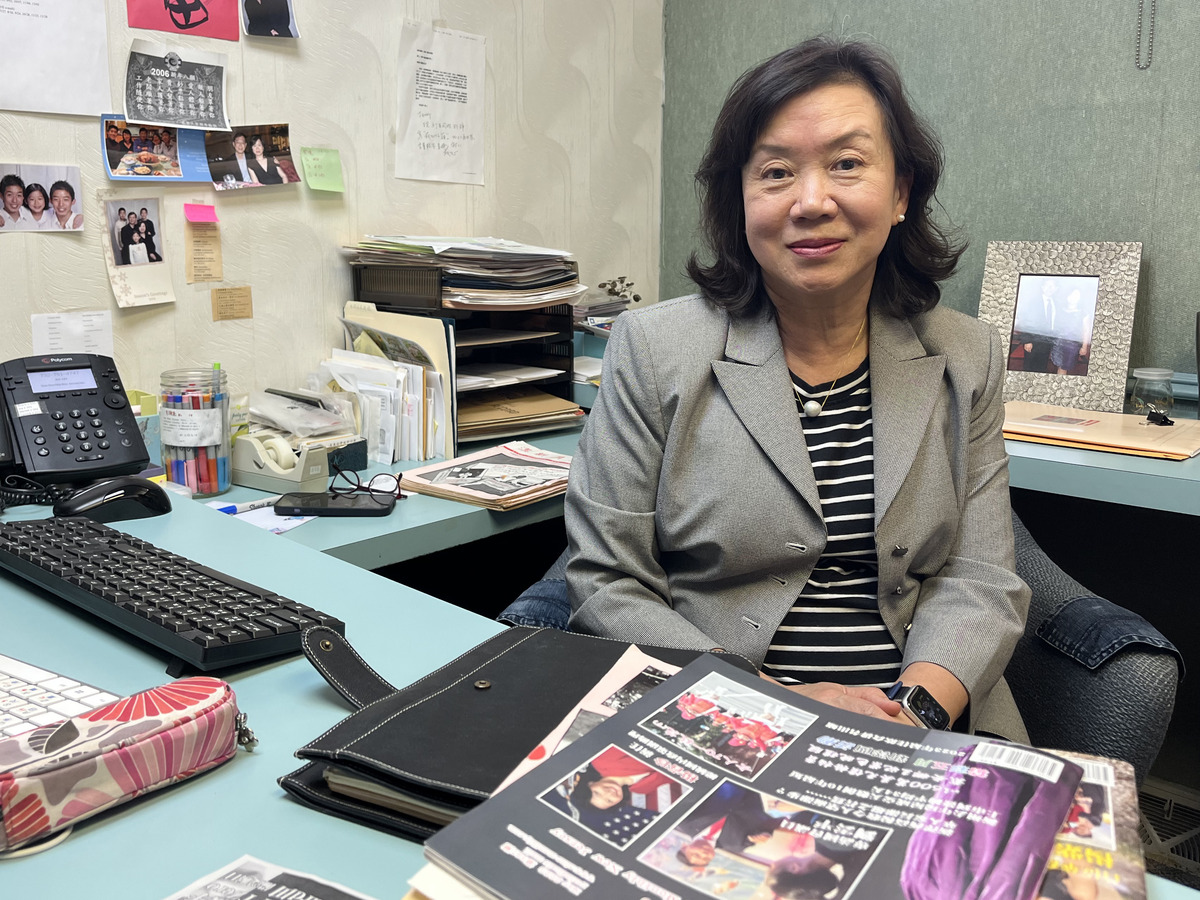Ivy Lee is the founder and editor of the independent Chinese-language magazine Sino Monthly. She likens it to milk: “Milk has nutrition. It’s very inexpensive and very easy to get.”
Mary Yang/NPR
hide caption
toggle caption
Mary Yang/NPR


Ivy Lee is the founder and editor of the independent Chinese-language magazine Sino Monthly. She likens it to milk: “Milk has nutrition. It’s very inexpensive and very easy to get.”
Mary Yang/NPR
EDISON, N.J. – Bundles of free newspapers are stacked by the doors of Chinese supermarkets in New Jersey. Plastered with brightly colored ads, most are backed by powerful institutions, be they religious groups, the spiritual movement Falun Gong or news agencies affiliated with the Chinese government in Beijing.
Sino Monthly, a magazine that costs $1.25 per issue, stands out among the Chinese-language press for something else: its independence. It was founded by a local couple in 1991. They’re still at the helm.
“My magazine is like milk,” founder and editor Ivy Lee says when asked about how Sino Monthly has survived for so long. “Milk has nutrition. It’s very inexpensive and very easy to get.”
Sino Monthly, with six people on the payroll, never aimed to be a paper of record. In fact, it is one, having become a staple for New Jersey’s Chinese community.
“We tell the readers where the Chinese are”
Ethnic media outlets can be a lifeline for new immigrants who lack a firm grasp of English. They introduce their readers to civic life in America and to each other. They can be especially helpful in places like New Jersey, where communities are spread out rather than concentrated in big cities. In this state, ethnic media is growing, according to a new report by the Center for Cooperative Media at Montclair State University.
The first issue Sino Monthly, at just 16 pages, led with newly released figures from the 1990 census. It counted 59,084 people living in New Jersey who said they were Chinese. (That figure has since more than doubled.)
“We tell the readers where the Chinese are,” says Lee.
Jennifer Lu, a yoga instructor who’s lived in New Jersey for nearly 40 years, says she used to read articles from Sino Monthly to her children, now in their 20s and 30s.
“It’s a big help, especially to people who just moved to New Jersey or the United States,” says Lu. “There are still many elders who don’t know how to use computers, who still very much depend on the magazine.”
Sino Monthly is nonpartisan but Lee says part of its mission is encouraging readers to participate in the politics of their new home. The title of one October 1994 article ahead of the midterm election read, “拜托! 拜托! 投下您神圣的一票”
Translation: “Please, please cast your sacred vote.”
Today, the magazine’s coverage spans politics, the economy and culture. One recent story profiled the White House deputy assistant on race and equity, Jenny Yang, who grew up in New Jersey. Another shared the beauty secrets of local women in their 70s.


Rutgers librarian Tao Yang maintains an archive of Sino Monthly issues. They will help future historians understand New Jersey’s Chinese community, he says.
Mary Yang/NPR
hide caption
toggle caption
Mary Yang/NPR


Rutgers librarian Tao Yang maintains an archive of Sino Monthly issues. They will help future historians understand New Jersey’s Chinese community, he says.
Mary Yang/NPR
A record for future historians
Rutgers University Librarian Tao Yang maintains an archive of Sino Monthly issues on three shelves in the basement of the school’s East Asian Library. He says they serve as a record of New Jersey’s Chinese community, and will help future historians understand its growth into one of the largest in the U.S.
“Not just the cultural issues or the political perspectives, but also the economic conditions,” Yang says. “Even advertisements are useful.”
He notes Lee’s introduction from 1991. It reads in Chinese: “Most of the time,mainstream mediadoesn’t have a lot of news about Chinese people. So the result is, if Chinese people have any issues, no one will know about it.”
“Chinese people don’t have access to mainstream media, and mainstream media doesn’t cover Chinese people,” the introduction continues.
“We still face the same problem today,” says Yang.
He says he frequently spots copies of Sino Monthly in his friends’ homes when he visits them. But he worries that preservation will become an issue as more and more news goes online, and physical newspapers decay.
“That’s the issue with collecting newspapers and periodicals. They’re not supposed to last forever,” says Yang, pointing to the yellowed pages of the 1991 issue.
Yang says preserving the original print copies is important, even when it seems like everything can be found online. “I’m a little bit afraid the history – historical record of [the] Chinese community — will be lost again in the digital space,” he says.
Ethnic media thrives in print, researcher says
In addition to hard copies, Sino Monthly now has an e-magazine and a presence on Facebook and WeChat.
“We have to keep pace with the world,” Lee says.
But, unlike so many other news outlets, getting rid of print magazines has never been a consideration.
“We still have many loyal readers,” she says. “The older readers, they’re still used to the paper magazine.”
Ethnic media outlets thrive on print, says Anthony Advincula, the lead author of Montclair State University’s report.
“The insularity of ethnic media, in terms of their sustainability, helps them a lot,” says Advincula, describing a symbiotic relationship between the small news outlets and their advertisers.
Advertisers, often readers themselves, find in those pages a market of customers seeking service providers who speak their language.
Those ads, from local businesses such as real estate agents and insurance agencies, help ethnic media outlets generate more revenue from paper issues than online, Advincula says.
“They know their market: ‘Let’s stay in our lane,'” he says. “And they’re okay.”
“I think the biggest challenge is right now”
Yet the future of Sino Monthly is far from certain. The pandemic made publishing and reaching readers more challenging, and Lee moved both of her publications — Sino Monthly and the ad-filled Chinese News Weekly — under the same roof, closing the office that housed her weekly newspaper.
During the pandemic’s early months, Sino Monthly took advantage of the government financial assistance offered to small businesses.
“After the pandemic, you thought the economy would rise up. But actually not,” says Lee. “I think the biggest challenge is right now.”
Lee is now 63. Her husband retired from his full-time job in software development a few years ago. They’re discussing what to do about Sino Monthly. Though she hasn’t found a successor yet, Lee says she refuses to let her magazine close.
“My business started from ground zero,” says Lee. “So I know how to survive.”
This story originally appeared on NPR






